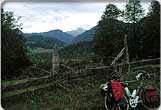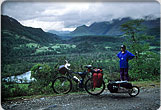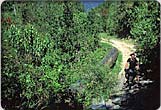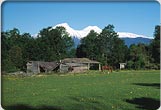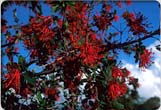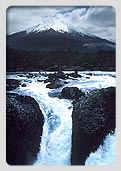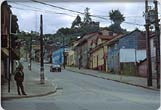| Santiago to Puerto Montt |
| October 13 1997 and I arrive jet lagged in Santiago during a thunder storm. Once through customs I'm besieged by touts. "Oh no" I think "the third world hassle I've heard so much about". But wait, this tout... he's phoning accommodation for me - from my list, he's arranging a shared minibus to take me there, he's, he's... refusing a tip! After four or five cliche busting days in Santiago I've discovered that (a) Santiago is the safest feeling city I've ever visited, (b) there is a lot more wealth here than I was expecting, (c) Chilenos are shopaholics and (d) the food is bland. Oh, I also discovered that earthquakes scare the pants of me and standing in a doorway during one doesn't make me feel any safer. Hang in there for photos dear reader. I got off to a slow start, but once you read down the page to the Lakes District you'll find them. The rest of the site is lavishly illustrated although camera troubles early on in the trip mean some of the pics are a bit dark. Once over the jet lag and provisioned up I'm ready to roll south. My initial thought is to get a train south to Talca, Chillan or Temuco to get clear of the industry and traffic south of Santiago. Temuco would also offer a quick intro to the lakes district. In the event I discover no trains with luggage wagons (for the bike) are running on the day and on a whim decide to cycle west out of the city to Melipilla, then turn south and try to avoid the Route 5 highway. Had I known at the time that buses are the cheap, fast and reliable form of motorised public transport in Chile, I'd probably have walked the 50 metres from the train to the bus station. The first days ride to Melipilla is along a busy road. The first twenty ks through heavy traffic with a million deranged minibuses and a soft shoulder. After that the road has a hard shoulder and the traffic is less manic. South from Melipilla I follow a narrow winding road through hills to Lago Rapel - an immensely popular weekend camping area for the Santiago populace. Minibuses are still a nuisance on the narrow road. Another days ride and I'm dumped back on Ruta 5 near San Fernando. Poring over the map I notice that unless I head to the coast and follow dirt tracks along it I will always be dumped back on Ruta 5 - roads run off the highway but don't then mesh into a consistent grid. I elect to follow the highway south as long as the bonus unopened (to motor traffic) dual carriageway continues. At first I figured I would get a few kilometres relief from the traffic by riding along the unopened lane - as it turned out I got a great many days riding - almost all the way to the Lakes district in fact - along newly built traffic free roadway. It seems the road building contractors were more adept at building to schedule than the bridge builders... The scenery going south was a dissapointment - the Andes only just visible to the left, and often obscured by haze. The farmland was agribusiness expanses and the towns rambling spreads with dull concrete low rise (earthquakes!) buildings and shops - lots of shops! Bike shops were amazing - many stocked high end gear like Campag and had featherweight racers in the windows. This area is the heartland of road racing in Chile. Whitegoods shops stocked Chilean made Bianchi and Larsen bikes. These were often full suspension MTBs, but closer inspection revealed low-end components. My favorite being the "Block Shoks" where you'd expect to see "Rock Shoks". Some towns had elaborate cycle paths, often with engineering and attention to detail that left Australian cities attempts in the dust. At the town of Los Angeles I finally get off the Ruta 5 and follow lovely winding roads through Angol, Traiguen and Chol Chol to Temuco. For the first time I had realy to put in some effort to get over the hills. The scenery is improving by the day - becoming lusher, the farms becoming smaller. At last I think "I realy should be taking photos". |
| At Villarrica I try unsuccessfully to find "La Torre Suiza" a popular cyclists haunt in this german/swiss settled town. The lovely hotel I end up at is run by a Swiss man. Further questioning reveals that, despite his German accent, his grandparents were the immigrants - he has hung onto their legacy and considers himself Swiss. This seems common in the region. From Villarrica I head around the lake and Volcano of the same name to Pucon, a backpackers and outdoor adventure sports mecca. From there I head into the Andes to camp at a small hotsprings for a few days. Picture taken near the springs. |
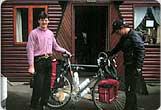 |
Back in Villarrica I find "La Torre Suiza" (link opens in new window) and move in for a few days to avoid the heavy rain and enjoy the company. The Swiss owners (yes, realy this time) Beat and Claudia spent a few years cycling around the world but ran out of steam when they reached Chile and decided to open a backpackers. Cyclist discounts of course. This is a great place to meet other cyclists and share route information. 2013 update: Beat and Claudia have moved back to Switzerland and all references to cycle touring have been removed from the site. |
| The Lakes District has fabulous scenery and good roads. Outside school holidays the traffic is light. Lakes, forests and volcanoes make for meandering roads. I cycle for a few days with Andi Wever (link opens in new window - website in German), a German towing a BOB Yak trailer. We ride to Puerto Fuy hoping to follow a dirt track through the mountains to Llifen on Lago Ranco but the road is a private one and we backtrack to Choshuenco where we have to decide on the road to Panguipulli or the track to Rinihue. The Rinihue track has been closed since bridges were washed away in floods. It is no longer maintained. We meet an Australian pair on bikes who have just come that way. It is "do-able" they say. Remind me, next time I'm in Bellingen, to search them out and kill them. Eventually, after crossing the icy river in the wrong place a number of times we give up and camp for the night. Next morning we find the correct track. It takes a whole very, very long day on a steep, loose, rough, washed-out jeep track to reach Rinihue. Of course, once the fatigue and hunger had been forgotten, it became one of the highlights of the trip. Approaching Rinihue we came across some locals and asked if there was somewhere to stay in town. Yes, they reply, drunkenly. Further down the track we encounter a drunken horse rider, lucky not to be thrown as his horse rails beneath him, his kids egging it on. Closer to town and more drunks. We thought there had been a wedding or funeral wake! The whole town is totally blotto. Ask anyone if there is anywhere to stay and they all say "at my house" before wrapping you in their arms and breathing beerily over you. In the end we camp on the beach. Next day we discover Chile had qualified for the Football World Cup. For a more recent (December 2013) look at the state of this "road" look here (link opens in new window), it has degraded further in the 16 years since my ride BUT it's still passable - and the good news is the cyclists at the link met surveyors en-route and the track may be rebuilt in the next few years. At least Andi and I didn't have to cut our way through thorny thickets. |
| I spent two weeks having Spanish lessons in Puerto Montt, a lovely fishing town of shingle houses at the bottom of the Lakes district. I can highly recommend the lessons and the accommodation at Casa Perla (aka Casa Uribe) in Trigal Street. I'm sure my tutor Efrain still considers me a lost cause, but believe it or not, those lessons did pay off! The lessons were great - the student a bit thick. |
|
Home :: Santiago to Puerto Montt :: Isla Chiloe :: Carretera Austral :: Esquel to Mendoza :: Argentina to Antofagasta :: Around San Pedro :: San Pedro to Bolivia :: Bolivia :: Bolivia to Santiago
|
